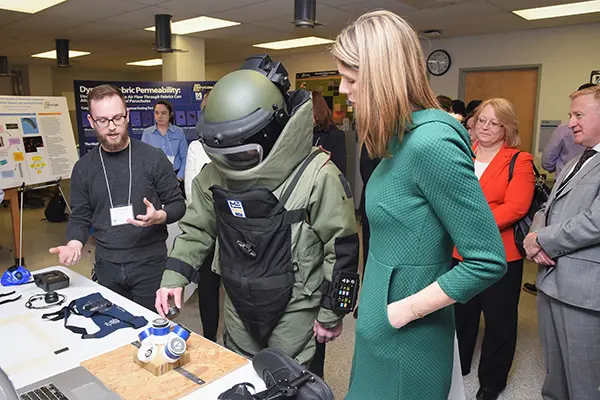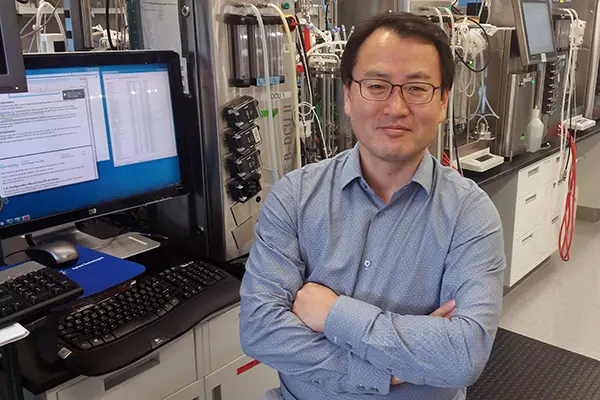New Partnerships Expand University’s Research Portfolio
 Image by U.S. Army
Image by U.S. Army
04/29/2019
By Edwin Aguirre
In the university’s labs and research centers, engineering faculty and student researchers are developing innovative materials and technologies that can help improve people’s lives – from self-healing materials for cars that can repair themselves to nanomedicine and imaging techniques that could lead to breakthroughs in the diagnosis and treatment of cancer and Alzheimer’s disease.
These are just a few examples of new research initiatives underway at the Francis College of Engineering that are leading to advances in everything from biopharmaceuticals to nanotechnology and cybersecurity.
Expanding the research enterprise has been a priority of Dean Joseph Hartman. The expansion not only provides new hands-on learning opportunities for students, but it also supports economic development.
“It is clear that universities can be economic engines, but this does not happen through course offerings. It is achieved through research and development,” says Hartman.
That is why the Francis College of Engineering has developed a broad and diverse portfolio composed of basic research funded by the National Science Foundation (NSF) and the U.S. Department of Defense (DoD), as well as applied work with tech companies throughout the Northeast.
“Given our founding as a developer of solutions for the textile industry, it is no surprise that our college heavily engages with industry to find solutions to pressing problems of today and tomorrow,” says Hartman. “In fact, a third of our research expenditures in 2018 were from industry.”
It is this willingness and ability to partner with industry that has led to the college’s leading participation in a number of Manufacturing USA Institutes, including those in additive manufacturing (America Makes), biopharmaceutical manufacturing (NIIMBL), functional fabrics (AFFOA), robotics (ARM), composites manufacturing (IACMI), flexible electronics (NextFlex) and plastics recycling and reuse (REMADE).
Faculty and students are also conducting federally funded research through the NSF Industry/University Cooperative Research Centers in wind energy (WindSTAR), biomanufacturing (AMBIC) and additive manufacturing (SHAP3D), as well as increased interaction with the Combat Capabilities Development Command (CCDC) Soldier Center (formerly the U.S. Army Natick Soldier Research, Development and Engineering Center) through the university’s HEROES program. HEROES stands for “Harnessing Emerging Research Opportunities to Empower Soldiers.”
In addition, the university has established state-of-the-art centers such as the new Fabric Discovery Center in downtown Lowell and the Raytheon-University of Massachusetts Lowell Research Institute (RURI) and the Printed Electronics Research Collaborative (PERC), both based at the Saab Emerging Technologies and Innovation Center on North Campus. It also opened the new UMass Lowell Research Institute (UMLRI) in Lincoln, Mass., to increase engagement with DoD.
“These efforts have resulted in the highest external research expenditures ever by the college, totaling $27.9 million in the past fiscal year – a nearly threefold increase compared to five years ago,” notes Hartman. Highlighted next are just a few of the ongoing research programs on campus.
SLIMM and SLIMMER
Research and development efforts at HEROES recently received a huge boost when the Army awarded the program two grants, totaling nearly $8.5 million. HEROES is a joint R&D collaboration between UMass Lowell and the CCDC Soldier Center to help protect, sustain and improve the mobility and quality of life for military personnel in the field.
The first grant, worth $4.2 million, will fund the SLIMM (Soldier Lightweight Integrated Multifunctional Materials) projects, which include the development of novel high-performance moisture- and oxygen-barrier thin films for flexible electronics, efficient thermoelectric materials for conformable lightweight power, extended-life flexible photovoltaic power sources, thermoresponsive fibers for lightweight, smart thermal insulation, new sapphire-based materials for transparent armor, multilayer elastomer laminates for chemical protective clothing, coatings that repel liquids and ice, and durable flame-retardant coatings.
The second grant, also worth $4.2 million, will support SLIMMER (Soldier Lightweight Integrated Multifunctional Materials and Exoskeleton Research) projects.
“SLIMM doesn’t involve exoskeleton research; SLIMMER does,” says plastics engineering Prof. Ramaswamy Nagarajan, who is co-director of HEROES. “These programs are running concurrently, and they have overlaps in the areas of thermoelectrics, multifunctional coatings and ultrabarrier materials for flexible electronics.”
SLIMMER projects will study blast protection of extremities of soldiers defusing an improvised explosive device using laminate elastomer/rigid systems, develop a smart sensing system for early detection of damage in helmets and body armor and conduct biometric studies on how physical and cognitive stresses on the body affect people wearing an exoskeleton or heavy, bulky bomb suit.
“The unique aspect of SLIMM and SLIMMER is that they bring together complementary expertise of faculty members from three different colleges – the Francis College of Engineering, the Kennedy College of Sciences and the Zuckerberg College of Health Sciences – to solve complex problems relating to safeguarding our soldiers on the front line,” notes Nagarajan.
UMLRI Opens Its Doors
The UML Research Institute officially opened for business last November, with a ribbon-cutting ceremony attended by Lt. Gov. Karyn Polito and Chancellor Jacquie Moloney, among others. With its location just outside the gates of Hanscom Air Force Base, UMLRI is leading a focused initiative that links the UMass system’s core strengths in engineering and science to the DoD’s requirements to provide rapid and innovative solutions for defense and commercial customers.
The UMLRI, under the direction of Matthew McSwain of UMass Lowell, will help UMass faculty forge new research ties with the DoD, facilitate academic and training initiatives and support the DoD’s Small Business Innovation Research (SBIR) efforts in the Northeast.
“UMLRI will help solve some of the DoD’s most complex problems and help maintain our country’s competitive advantage and global leadership in innovation and technology,” says McSwain. “Our goal is to retain defense dollars and jobs within Massachusetts by establishing the state’s first-of-its-kind nonprofit, defense-focused institute that would deliver game- changing technologies to the front line and provide university engineers and scientists opportunities for impactful work previously not available.”
UMLRI’s federal funding is $4.6 million for the first 18 months; current funding also includes academic tuition revenue and SBIR research grants from the DoD as well as the U.S. departments of Energy and Homeland Security. UMass Lowell and the other four UMass campuses will provide expertise in the fields of artificial intelligence and machine learning, biomanufacturing, nanomanufacturing, advanced additive manufacturing, cybersecurity, robotics, energy storage, nuclear engineering, materials characterization and other specialized disciplines.
“This institute creates opportunities for our students to work on significantly large DoD contracts and engineering projects never before available to them,” says McSwain.
Advances in Biopharmaceuticals and Biomanufacturing

NIIMBL, which stands for the “National Institute for Innovation in Manufacturing Biopharmaceuticals,” was formed in 2016 to advance U.S. leadership in the biopharmaceutical industry, foster economic development, improve medical treatments and ensure a qualified workforce by collaborating with educational institutions to develop new training programs to match the skill needs of the biopharmaceutical industry.
The University of Delaware is the project’s overall lead, with UMass and MIT as major partners. UMass is spearheaded by UMass Lowell and UMass Medical School’s MassBiologics. Yoon heads the effort for UMass Lowell, with help from Assoc. Prof. Carl Lawton of the Department of Chemical Engineering as well as the Massachusetts Biomanufacturing Center on North Campus.
Unlike other conventional medicines, biopharmaceutical drugs are manufactured in or extracted from living biological cells, requiring complex manufacturing processes. Biopharmaceuticals treat and prevent such diseases as cancer, diabetes, neurological and autoimmune disorders, and bacterial and viral infections. The global market for biopharmaceuticals is expected to reach $300 billion by 2020.
“This industry also plays a crucial role in America’s homeland security by developing flexible, rapid manufacturing capabilities to help drug makers to quickly respond to outbreaks of pandemic diseases like Ebola, bird flu and other biological threats and treat U.S. soldiers, first responders and health care workers,” notes Yoon.
Yoon also co-directs the AMBIC initiative at UMass Lowell. AMBIC, the Advanced Mammalian Biomanufacturing Innovation Center, is a collaboration with Clemson University, Johns Hopkins University and the University of Delaware. The center focuses on developing knowledge, design tools and methods that apply and integrate high-throughput and genome-based technologies to fast-track advanced biomanufacturing processes.
The U.S. biomanufacturing industry is one of the fastest-growing and most important contributors to the country’s economic activity, producing commercially important biomaterials and biomolecules for use in medicine, food and beverage processing and industrial applications.
“AMBIC’s goal is to implement engineering innovations to enhance the country’s biomanufacturing capabilities and improve its competitiveness, leading to more economic investment by companies and more jobs for American workers,” says Yoon.
The Shape of Things to Come
Additive manufacturing – more commonly known as 3D printing – is one of the fastest-growing industries today. At the NSF-funded Science of Heterogeneous Additive Printing of 3D Materials (SHAP3D) Center, researchers from UMass Lowell, Georgia Institute of Technology and the University of Connecticut are focused on designing new materials and methods for 3D printing.
“Our work encompasses many different additive printing/manufacturing methods and will enable the design and creation of new material feedstocks, understand the material properties, protocols and design rules used in 3D printing and develop new 3D printing methods for novel materials and composites,” says UML plastics engineering Prof. Joey Mead, who is the director of the SHAP3D Center.
According to Mead, in an NSF Industry/University Cooperative Research Center, funding from the science agency and pooled member fees are used by university faculty and students to conduct precompetitive, industry-defined research projects. Industry members then have access to the research to expedite commercialization of new materials, printing methods and products.
“Our vision is to provide industrial participants with new, validated materials with tunable properties and superior functionality for real-world applications,” says Mead.
Aside from Mead, other faculty researchers include mechanical engineering Assoc. Prof. Christopher Hansen (the UML SHAP3D site director), plastics engineering Profs. David Kazmer and Carol Barry and chemical engineering Assoc. Prof. Nese Orbey.
